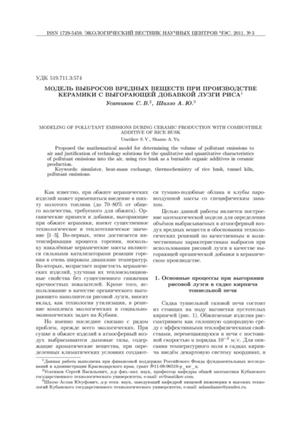Модель выбросов вредных веществ при производстве керамики с выгорающей добавкой лузги риса
УДК
519.711.3:574EDN
ONROKVАннотация
Предложена математическая модель для определения объёмов выбрасываемых в атмосферный воздух вредных веществ и обоснования технологических решений по качественным и количественным характеристикам выбросов загрязняющих веществ в атмосферный воздух при использовании рисовой лузги в качестве выгорающей органической добавки в керамическом производстве.
Ключевые слова:
математическая модель, тепломассобмен, термохимия рисовой лузги, тоннельная печь, выбросы вредных веществИнформация о финансировании
Данная работа выполнена при финансовой поддержке Российского Фонда фундаментальных исследований и администрации Краснодарского края, грант №11-08-96519-р_юг_ц.
Библиографические ссылки
- Нохратян К.А. Сушка и обжиг в промышленности строительной керамики. М.: Гос.изд.лит. по строит., архит. и стройматер., 1962. 603 с.
- Сергиенко В.И., Земнухова Л.А., Егоров А.Г., Шкорина Е.Д., Василюк Н.С. Возобновляемые источники химического сырья: комплексная переработка отходов производства риса и гречихи // Рос. хим. ж. (Ж. Рос. хим. об-ва им. Д.И. Менделеева). 2004. Т. XLVIII. №3. C. 116-124.
- Al-Marahleh G. Production of Light Weight Ceramics Teils from Local Materials // American Journal of Applied Sciences. 2005. Vol. 2. No 3. P. 778-783.
- V. de Paulo Nicolau, Dadam A.P. Numerical and Experimental Thermal Analysis of a Tunnel Kiln used in Ceramic Production // J. of the Braz. Soc. of Mech. Sci. & Eng. 2009. Vol .31. No 4. P. 297-304.
- Williams P.T., Nugranad N. Comparison of products from the pyrolysis and catalytic pyrolysis of rice husks // Energy. 2000. Vol. 25. P. 493-513.
- Markovska I.G., Lyubchev L.A. A study on the thermal destruction of rice husk in air and nitrogen atmosphere // Journal of Thermal Analysis and Calorimetry. 2007. Vol. 89. No 3. P. 809-814.
- Chiang W.-F., Fang H.-Y., Wu C.-H., Chang C.-Y.; Chang Y.-M., Shie J.-L. Pyrolysis Kinetics of Rice Husk in Different Oxygen Concentrations // Journal of Environmental Engineering. 2008. Vol. 134. No 4. P. 316-325.
- Xiujuan G., Shurong W., Qi W., Zuogang G., Zhongyang L. Properties of Bio-oil from Fast Pyrolysis of Rice Husk // Chinese Journal of Chemical Engineering. 2011. Vol. 19. No 1. P. 116-121.
- Baker E.G., Brown M.D., Elliott D.C., Mudge L.K. Characterization and Treatment of Tars from Biomass Gasifiers // Denver, CO: AIChE 1988 Summer National Meeting, P. 1-11.
- Evans R.J., Milne T.A. Chemistry of Tar Formation and Maturation in the Thermochemical Conversion of Biomass // in Developments in Thermochemical Biomass Conversion. Vol. 2. Edited by A.V. Bridgwater and D.G.B. Boocock. London: Blackie Academic & Professional. 1997. P. 803-816.
Скачивания

Даты
Поступила в редакцию
Принята к публикации
Публикация
Как цитировать
Лицензия
Copyright (c) 2011 Усатиков С.В., Шаззо А.Ю.

Это произведение доступно по лицензии Creative Commons «Attribution» («Атрибуция») 4.0 Всемирная.


